
There are an abundance of things to do and see in and around McLeod Ganj.
The following list is just a taster of what's available:
Public Audiences
His Holiness the Dalai Lama: you can find out when the next public audience will be at the
Branch Office in McLeod Ganj (above the Welfare Office on Bhagsu Road).
The 17th Karmapa Lama: holds an audience daily at 2pm at Gyuto Monastery, 2kms from the Norbulingka Institute.
Norbulingka Institute of Tibetan Culture (www.norbulingka.org)
A trust founded by the Department of Religion and Culture dedicated to preserving literary
and artistic Tibetan culture in exile, which shouldn't be missed. It derives its name from
His Holiness the Dalai Lama's beautiful summer residence, the Norbulingka (Jewel Garden), set
in parkland two kilometers from Lhasa. The complex of Tibetan styled buildings, built in 1985,
is set amid peaceful Japanese gardens. The gilded copper statue of Sakyauni in the Deden
Tsuglakhang Temple is the largest of its kind outside Tibet.
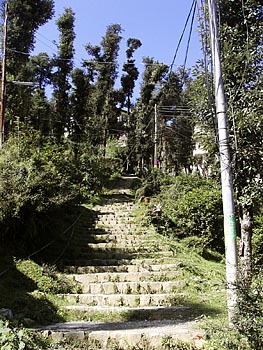
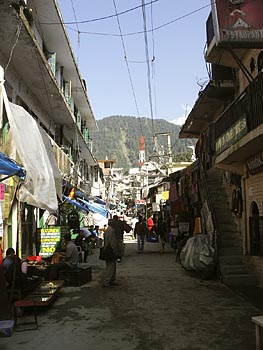
Library of Tibetan Work & Archives
Tibetan language (beginner and advanced) and Buddhist philosophy courses are held each weekday.
Other facilities include: a foreign language reference library containing 10,000 titles in English
and other languages concerning Buddhism, Tibet and related subjects; a museum preserving about 1,000
sacred objects from Tibet; and a book store. Contact: lwta@gov.tibet.net
Meditation & Retreats
Tibetan Buddhist meditation courses and retreats are held at the TUSHITA MEDITATION CENTRE at Dharamkot
(approx. 2kms from McLeod Ganj). The VIPASSANA CENTRE, next to Tushita, runs ten-day silent retreats and
daily sittings. Contacts: tushita@ndf.vsnl.net.in and dsikhara@yahoo.com.
Apart from these two centers you can find many other places to practice meditation, yoga, Reiki, massage
(Tibetan, Ayurvedic, Shiatsu and Thai), martial arts, languages (Tibetan and Hindi) or why not cooking classes!


The Dalai Lama's Residence & Tsug Lakhang Temple
The Dalai Lama settled here in 1960 and his residence on the south edge of town has become his
permanent home in exile. In front of his private enclosure, Dharamsala's main Buddhist temple,
Tsug Lakhang, shelters images of Sakyamuni, Padmasambhava and Avalokitesvara. Every afternoon
monks from the nearby Namgyal monastery hold fierce but disciplined debates in the courtyard
opposite the temple.
Tibet Museum (www.thetibetmuseum.org)
The museum displays in graphic detail the plight of the Tibetan people since China invaded Tibet in 1949.
GU-CHU-SUM
Established in 1991, Gu Chu Sum provides support to ex-political prisoners and their families. There is
a permanent photographic exhibition hall here where you can learn more about Tibetís history under Chinese occupation.


Tibet Institute of Performing Arts (www.tibetanarts.org)
Established in 1959, TIPA was the very first institution in exile. It is the home of lhamo,
the arrestingly colorful and unique folk opera of Tibet. TIPA preserves a wide repertoire of
musical, dance and theatrical traditions from Tibet and hold regular performances throughout the year.
Church Of St. John In The Wilderness
Fifteen minutes' walk from McLeod Ganj, the Anglican Church lies in the forest near Forsyth Ganj.
This neo-Gothic stone church was built in 1852 and has some fine Belgian stained-glass windows. It
miraculously survived the 1905 earthquake - only the spire collapsed. A memorial to Lord Elgin stands
in the churchyard. The British Viceroy died in Dharamsala and is buried here.
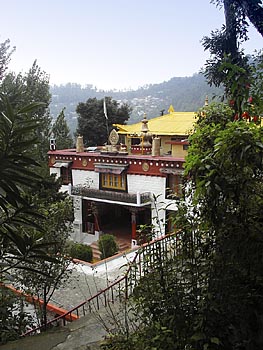

Bhagsu
Situated 2kms east of McLeod Ganj, it is the site of an ancient Shiva temple, attracting many Indian tourists
at the weekend. Just beyond the temple a path meanders up the boulder-strewn slopes of a small stream up to a waterfall.
Trekking
McLeod Ganj is one of the most popular starting points for treks over the rocky ridges of the
Dhauladhar Range, which rise steeply from the Kangra Valley to 4,600 meters. The most frequented
route is over the Indrahar Pass (4350m), which takes between four to five days. However, you can
also go on a one-day trek (9kms) to a grassy plateau at Triund (2975m).
Volunteering
There are countless volunteering opportunities for those who wish to share their tie and knowledge.
These are primarily for English and French teachers (no experience required) but assistance is also
sought for environmental and computer projects.
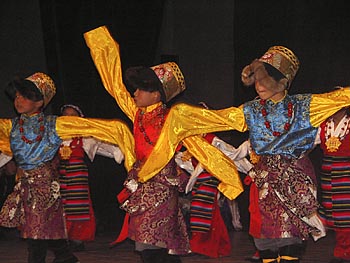
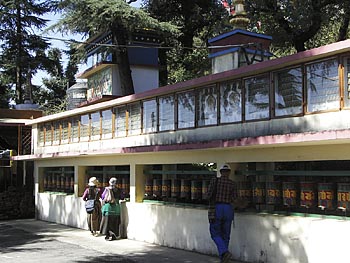
Other
There are three small cinemas in town showing new releases, Tibetan interest movies and documentaries
and old Hollywood and Bollywood classics.
McLeod Ganj is a place where sitting, chatting and philosophizing in restaurants and cafes is a favored
activity, which also makes it very easy to meet new friends. You can also find a wide variety of cuisine on offer.
MAP & DIRECTIONS
Intersected by two narrow roads, the focal point of McLeod Ganj is its Buddhist temple
(currently under renovation), ringed with spinning red and gold prayer wheels. The buildings
of the town are decked with white, red, green, blue and yellow prayer flags fluttering in the wind.
Itís easy to find your way around McLeod Ganj. At its northern end, the road up from the lower town
arrives at a small square that serves as the bus stand. Roads radiating from here head: south to
the Dalai Lamaís residence and the Library of Tibetan Works and Archives; north to the village
of Dharamkot, the Tushita Retreat Meditation Centre and to the Tibetan Childrenís Village
next to Dal Lake; and east to the hamlet of Bhagsu.
Map of McLeod Ganj